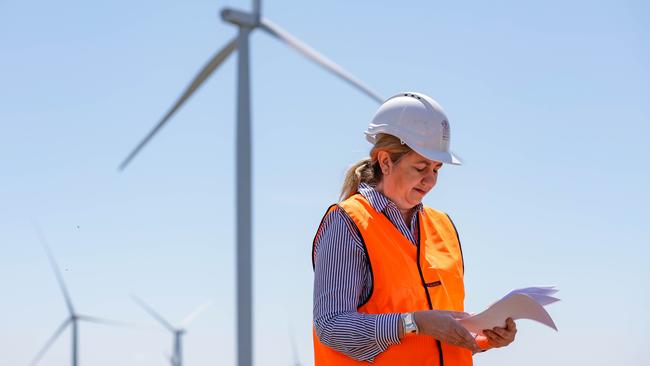Status quo for Queensland’s reduction targets
Queensland’s emission reduction target is expected to remain unchanged during an overhaul of the state’s energy strategy, despite plans to strengthen renewable energy goals.

Queensland’s emission reduction target is expected to remain unchanged during an overhaul of the state’s energy strategy, despite plans to strengthen renewable energy goals.
Premier Annastacia Palaszczuk will release the resource-rich state’s 10-year energy plan on Wednesday, setting out her government’s climate change agenda ahead of the 2024 state election.
Government sources say while Queensland was considering changing its renewables target to be “more ambitious” than its current 50 per cent by 2030 aim, its emission reduction goal would remain the same.
The Palaszczuk government’s target, to cut 30 per cent of greenhouse gas emissions on 2005 levels by 2030, lags behind Anthony Albanese’s federal goal of 43 per cent by 2030, which passed the upper house earlier this month.
NSW and Victoria have ambitions to cut their state’s emissions by 50 per cent by the decade’s end.
On the latest data, from 2020, Queensland has reduced emissions by 19 per cent since 2005, and 21.4 per cent of the electricity used in Queensland is produced from renewable energy sources.
Ms Palaszczuk will deliver her annual State of the State address at a Committee for Economic Development of Australia event on Wednesday, finally releasing details of how the government will achieve the renewable energy target it set in 2017.
The 10-year plan is expected to include extra funding to upgrade the state’s transmission network to accommodate increasing renewable generation, as recommended by Auditor-General Brendan Worrall in November.
Government and industry sources also anticipate Ms Palaszczuk will announce plans to increase batteries, firming and other storage options, to provide stability for the hike in renewables.
There is concern from unions and industry that the state needs more skilled workers, and more training for existing workers, to manage the transition from fossil fuels to renewables.
There is also increasing political pressure on the Premier from the Greens and conservationists for her to commit to shutting down Queensland’s state-owned, coal-fired power stations earlier than planned to help achieve both the renewables and emissions targets.
The Australian Energy Market Operator requires three years’ notice to be given before the shut-down of a coal-fired generator.
Queensland Greens MP Michael Berkman said if the state did not stop burning coal by 2030, it would cause Australia to breach its Paris climate obligations.
Energy Minister Mick de Brenni has repeatedly insisted the government will not – and does not need to – fast-track closure of the generators, the first of which is not scheduled to close until 2028.



To join the conversation, please log in. Don't have an account? Register
Join the conversation, you are commenting as Logout